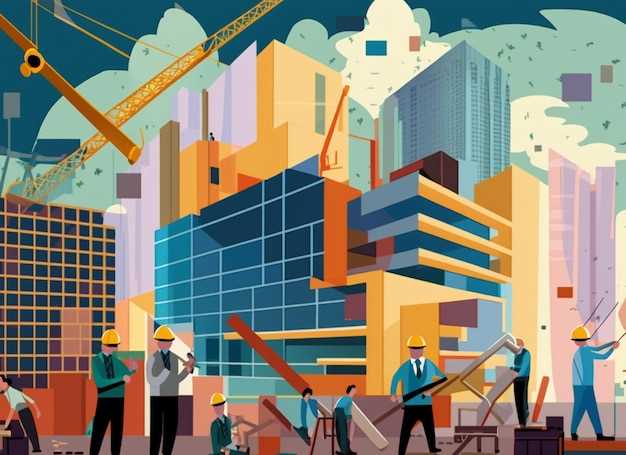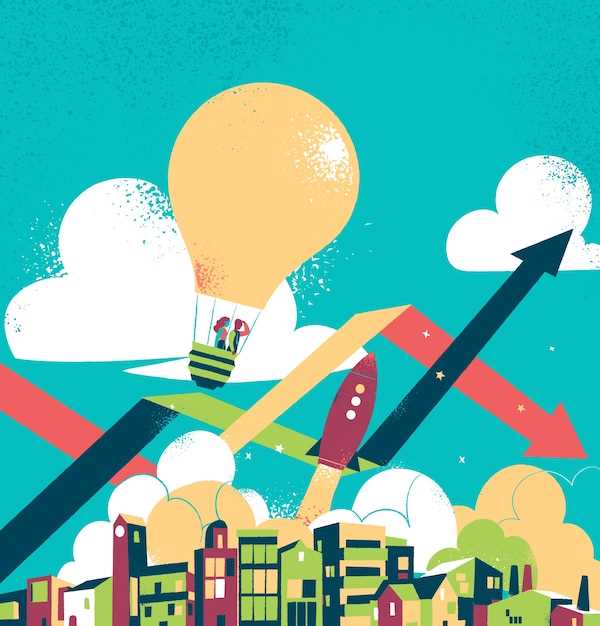
In the ever-evolving landscape of urban environments, a powerful force has emerged, shaping the very essence of our cities. This force, born from the creative minds of artists, has the ability to breathe new life into forgotten spaces, ignite a sense of wonder, and foster a vibrant sense of community. Through their innovative expressions, artists have become catalysts for change, sparking a wave of urban transformation and revitalization that transcends traditional boundaries.
By seamlessly blending the realms of imagination and reality, contemporary artists have redefined the way we perceive and interact with our urban surroundings. Their works, often characterized by their unconventional nature and thought-provoking messages, challenge the status quo and invite us to question our preconceived notions of what a city should be. Through the use of various mediums, such as murals, sculptures, and installations, these artists have the power to reshape the physical and emotional landscapes of our cities, creating spaces that are not only aesthetically pleasing but also deeply meaningful.
One of the most remarkable aspects of this artistic movement is its ability to transcend cultural and geographical boundaries. Whether in bustling metropolises or small towns, the impact of modern art on urban development knows no limits. Artists from all walks of life are reclaiming neglected spaces, transforming them into vibrant hubs of creativity and innovation. By infusing these areas with their unique perspectives and artistic visions, they are not only revitalizing physical spaces but also fostering a sense of pride and identity within the local communities.
Moreover, the influence of contemporary art on urban development extends beyond the visual realm. It has the power to stimulate economic growth, attract tourism, and create a sense of place. By transforming once-abandoned neighborhoods into cultural hotspots, these artistic interventions breathe new life into areas that were once overlooked or dismissed. They create a ripple effect, attracting businesses, entrepreneurs, and visitors, and ultimately contributing to the overall prosperity and vitality of the city.
Transforming Urban Spaces through Art Installations
Enhancing the aesthetic appeal and cultural vibrancy of cities, art installations have emerged as powerful catalysts for transforming urban spaces. These creative interventions breathe new life into neglected areas, fostering community engagement and revitalizing the urban fabric. By seamlessly blending art with the urban environment, these installations create immersive experiences that captivate and inspire both residents and visitors alike.
1. Redefining Public Spaces
Art installations have the remarkable ability to redefine public spaces, turning them into dynamic and interactive environments. Through the strategic placement of sculptures, murals, and other artistic elements, once mundane areas are transformed into captivating destinations. These installations encourage people to engage with their surroundings, sparking conversations and fostering a sense of pride and ownership among community members.
2. Celebrating Cultural Identity
Art installations provide a platform for celebrating and preserving the cultural identity of a city. By incorporating elements of local history, traditions, and heritage, these installations serve as visual narratives that reflect the unique character of the urban landscape. They not only honor the past but also contribute to the ongoing cultural dialogue, promoting a sense of belonging and fostering a deeper appreciation for diversity.
- Engaging the community in the creation process
- Encouraging social interaction and collaboration
- Attracting tourism and economic growth
- Challenging traditional notions of art and public space
- Addressing social and environmental issues through artistic expression
Art installations have the power to transform urban spaces into vibrant, inclusive, and thought-provoking environments. By harnessing the creative potential of contemporary art, cities can reimagine their landscapes, foster community connections, and create lasting legacies for future generations.
Fostering Community Engagement and Social Cohesion

In the context of the theme “The Impact of Contemporary Art on Urban Development and Revitalization,” this section explores the significance of fostering community engagement and social cohesion through artistic initiatives. By encouraging active participation and creating shared experiences, contemporary art plays a vital role in bringing diverse communities together and strengthening social bonds.
Creating Shared Spaces
One way contemporary art fosters community engagement is by creating shared spaces that encourage interaction and dialogue. Art installations, public sculptures, and murals transform urban landscapes into vibrant cultural hubs, inviting residents and visitors to explore and engage with their surroundings. These artistic interventions serve as catalysts for community gatherings, fostering a sense of belonging and shared ownership of public spaces.
Promoting Inclusivity and Diversity
Contemporary art also promotes inclusivity and diversity by providing a platform for underrepresented voices and perspectives. Through exhibitions, performances, and workshops, artists address social issues, challenge stereotypes, and celebrate cultural diversity. By showcasing a range of artistic expressions and narratives, contemporary art encourages dialogue, empathy, and understanding among community members, fostering social cohesion and breaking down barriers.
- Engaging Youth and Empowering Communities
- Encouraging Collaboration and Co-creation
- Enhancing Cultural Identity and Sense of Place
- Supporting Local Economies and Tourism
By engaging youth in artistic endeavors, contemporary art provides a platform for self-expression, skill development, and community involvement. Through art education programs and mentorship initiatives, young individuals are empowered to contribute to their communities and shape their own narratives.
Furthermore, contemporary art encourages collaboration and co-creation, bringing together artists, community members, and organizations to collectively address local challenges and envision a shared future. By fostering a sense of collective ownership and responsibility, these collaborative efforts strengthen social bonds and promote sustainable urban development.
Contemporary art also enhances cultural identity and a sense of place by celebrating local heritage, traditions, and stories. Through site-specific installations and community-led projects, artists engage with the unique characteristics of a neighborhood or city, fostering a deeper connection between residents and their environment.
Lastly, the impact of contemporary art on urban development and revitalization extends to supporting local economies and tourism. Artistic interventions attract visitors, stimulate local businesses, and contribute to the overall vibrancy and attractiveness of a city. By investing in artistic initiatives, communities can harness the economic potential of the creative sector while fostering community engagement and social cohesion.
Attracting Tourism and Economic Growth through Artistic Initiatives
Enhancing the allure of cities and fostering economic prosperity through innovative artistic endeavors has emerged as a powerful catalyst for attracting tourists and driving economic growth. By harnessing the creative potential of local artists and integrating their works into the urban fabric, cities can create vibrant cultural landscapes that captivate visitors and stimulate economic activity.
Fostering Cultural Tourism
Artistic initiatives play a pivotal role in transforming cities into cultural destinations, enticing tourists to explore the unique artistic expressions embedded within urban spaces. By showcasing a diverse range of art forms, including sculptures, murals, installations, and performances, cities can cultivate a rich cultural tapestry that appeals to both domestic and international tourists. These artistic attractions not only provide visitors with memorable experiences but also contribute to the local economy through increased spending on accommodations, dining, and retail.
Boosting Economic Growth
Artistic initiatives have the potential to generate significant economic growth by revitalizing underutilized areas and attracting investments. By transforming neglected spaces into vibrant cultural hubs, cities can attract businesses, entrepreneurs, and investors who recognize the value of a thriving arts scene. The presence of art galleries, studios, and creative industries not only creates employment opportunities but also stimulates the growth of ancillary businesses, such as cafes, boutiques, and hotels. This symbiotic relationship between artistic initiatives and economic development fosters a cycle of growth, benefiting both the local community and the city as a whole.
Enhancing the Aesthetics and Cultural Identity of Cities
Exploring the Influence of Contemporary Art on the Visual Appeal and Cultural Essence of Urban Areas
Preserving Authenticity through Artistic Expression
Art has the power to preserve and enhance the authenticity of cities, capturing their unique cultural identity and history. Through various forms of artistic expression, such as murals, sculptures, and installations, urban areas can be transformed into vibrant spaces that reflect the values, traditions, and stories of their communities. By integrating art into the urban landscape, cities can create a visual narrative that celebrates their heritage and fosters a sense of pride among residents and visitors alike.
Fostering Social Cohesion and Engagement
Contemporary art plays a crucial role in fostering social cohesion and engagement within cities. Public art installations and exhibitions provide opportunities for individuals from diverse backgrounds to come together, appreciate, and discuss artistic creations. By creating shared spaces for dialogue and interaction, art encourages a sense of belonging and community, breaking down barriers and promoting inclusivity. Moreover, the involvement of local artists and community members in the creation and curation of public art projects strengthens the bond between residents and their city, fostering a collective ownership and responsibility for its development.
| Benefits of Art in Urban Development |
|---|
| Enhances the visual appeal of cities |
| Preserves and celebrates cultural heritage |
| Fosters social cohesion and inclusivity |
| Creates opportunities for dialogue and engagement |
| Generates economic growth through tourism and cultural activities |
Art as a Catalyst for Sustainable Urban Development
Artistic expression has the power to ignite positive change within cities, fostering sustainable growth and development. By harnessing the creative potential of artists, communities can revitalize their urban landscapes, creating vibrant and inclusive spaces that promote social, economic, and environmental well-being.
Art serves as a catalyst for sustainable urban development by fostering a sense of identity and belonging among residents. Through public art installations, murals, and sculptures, cities can showcase their unique cultural heritage and create a sense of pride and ownership among community members. This sense of identity not only strengthens social cohesion but also attracts visitors and investors, stimulating economic growth and revitalizing neglected areas.
Furthermore, art can address pressing environmental challenges faced by urban areas. By incorporating sustainable materials and techniques into their creations, artists can inspire eco-friendly practices and raise awareness about climate change and resource conservation. Public art installations that utilize renewable energy sources or repurpose waste materials can serve as powerful symbols of sustainability, encouraging residents to adopt greener lifestyles and promoting a more sustainable urban environment.
- Artistic expression fosters social cohesion and a sense of identity among residents.
- Public art installations attract visitors and investors, stimulating economic growth.
- Art can address environmental challenges and promote sustainable practices.
- Artistic interventions can revitalize neglected areas and create vibrant urban spaces.
- Art serves as a powerful tool for community engagement and participation in urban development.
In conclusion, art plays a crucial role as a catalyst for sustainable urban development. By leveraging the creative potential of artists, cities can create inclusive and vibrant spaces that foster social, economic, and environmental well-being. Through public art installations, artistic interventions, and community engagement, cities can revitalize neglected areas, promote sustainable practices, and create a sense of pride and belonging among residents.
Empowering Local Artists and Creative Industries in Efforts to Revitalize Urban Spaces
In the context of urban renewal and rejuvenation, it is crucial to recognize the significant role that local artists and creative industries play in transforming and revitalizing urban areas. By harnessing their unique talents and perspectives, cities can tap into a wealth of creative potential that can breathe new life into neglected neighborhoods and foster a sense of community pride.
One of the key benefits of empowering local artists and creative industries in urban revitalization efforts is the infusion of authenticity and cultural diversity they bring to the table. These artists, who are deeply connected to the local community, possess an intimate understanding of its history, traditions, and aspirations. Through their artwork, they can tell stories that resonate with residents and visitors alike, creating a sense of place and identity.
Furthermore, supporting local artists and creative industries can have a positive economic impact on urban areas. By providing opportunities for artists to showcase and sell their work, cities can stimulate the growth of a vibrant creative economy. This, in turn, attracts tourists, art enthusiasts, and potential investors, leading to increased foot traffic, job creation, and overall economic development.
Empowering local artists and creative industries also fosters a sense of ownership and pride among residents. When individuals see their own community reflected in public art installations, murals, and performances, they feel a sense of belonging and connection. This sense of pride can lead to increased civic engagement, as residents become more invested in the well-being and future of their neighborhood.
Collaboration between local artists, community organizations, and urban planners is essential in ensuring that the revitalization efforts are inclusive and representative of the diverse voices within the community. By involving artists in the decision-making process, cities can create spaces that are not only visually appealing but also meaningful and reflective of the community’s values and aspirations.
- Empowering local artists and creative industries enhances the authenticity and cultural diversity of urban spaces.
- Supporting local artists stimulates economic growth and attracts visitors and investors.
- Local art installations foster a sense of ownership and pride among residents.
- Collaboration between artists, community organizations, and urban planners ensures inclusive revitalization efforts.
In conclusion, empowering local artists and creative industries is a vital component of urban revitalization efforts. By recognizing and harnessing their talents, cities can create vibrant, inclusive, and economically thriving spaces that reflect the unique character and aspirations of the community.


